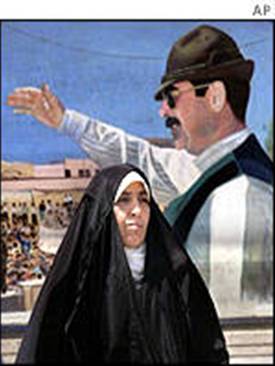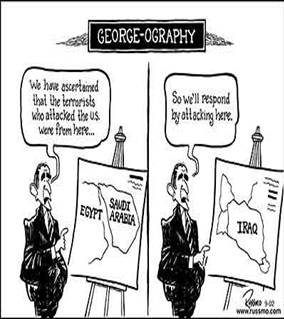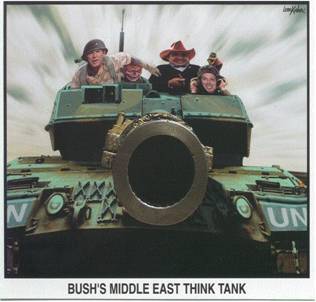
 Organ of Alliance Marxist-Leninist (North
America)
Organ of Alliance Marxist-Leninist (North
America)
How do we characterize Hussein?
Bluntly - he is a blood-thirsty dictator and
he has suppressed not only the Kurdish peoples, but his own peoples. He
has in particular suppressed the Communist and progressives.
For years as a member of the Ba’th Party, he was an instrument of the revisionist USSR’s power in Iraq, and then, he became an instrument of the US imperialists. It was the US imperialists who fed his thirst for blood. This exposes the hypocrisy of the USA’s leaders – when they piously call to depose him for the “good of the Iraqi peoples”.
We carry therefore a short history of modern Iraq,
highlighting Hussein’s role.

(i) The Modern State of Iraq
When the Ottoman Empire disintegrated, the Middle East was left in a vacuum. Into this stepped British imperialism, who disputed with France the oil of Mosul. The British won and simply created vassal states. These included in 1920, Iraq, Kuwait and Saudi Arabia. A kingdom was created under the rule of Faisal ibn Hussain. An arbitrary border between Iraq, Kuwait and Saudi Arabia was drawn by Sir Percy Cox, the British High Commissioner in Baghdad.
Iraq was administered by Britain under mandate from the League of Nations until 1932. Then it became an independent state under a new constitutional monarch, King Faisal I. Faisal, as a comprador agent of British rule, ensured British monopoly of the Iraqi Petroleum Corporation (IPC).
Until the Second World War seven successive coups left Iraq divided and unable to develop a national bourgeois revolt. The British played off the Shia Muslim masses against the minority Sunni Muslim rulers, and the Kurds against both Shias and Sunnis. The comprador agents ensured that between 1-3% of the population owned 55 % of all farmland. British monopoly of trade was complete.
King Ghazi – the son and successor of Faisal - colluded with General Bakr Sidqi of the Iraqi army to defy Britain. Even though shortly after Sidqi was assassinated, Ghazi held his course. This made him popular with the masses. He broadcast using a new radio station, messages of defiance to the British rule throughout the Middle East. The British arranged his assassination in a “car accident”, in 1939.
A pro-British agent Nur-Said came to power as a Prime Minister, while a regent took over the monarchy. By 1941 army colonels supported the Rashid Ali Keilani rebellion, which was pro-Nazi Germany. They allied with the Mufti of Palestine, a Nazi agent. The British therefore occupied the country in May 1941. British colonial rule extended till 1946. In 1947 the Portsmouth Anglo-Iraqi Treaty tried to ensure a neo-colonial presence in Iraq, with two Royal Air force (RAF) bases at Habaniyua and Sin Al Thibban.
This was hugely unpopular and led to uprisings – the al-Wathbah (The Leap). Under the leadership of the Iraqi Communist Party (ICP), uprisings forced the withdrawal of the puppet regime of Salih Jabr and the rejection of the Portsmouth Treaty. But the air force bases remained, and by 1955 the Iraqi state was part of the USA led plots to dominate the Middle East via the Baghdad Pact. The Government was led by Nuri al-Said, a comprador for the British at first, and then for the USA.
(ii) Arab Nationalism and the Ba’th party
Saddam Hussein was initially much influenced by the Rashid rebellion and the fate of Ghazi. He quickly joined the Ba’th Party.
The ideas of a so-called “Arab Socialism” were gaining favour. The Ba’th ('Renaissance' of the Arabs) party was founded in Iraq in 1954. Michel Aflaq and Zaki Arsouzi, in 1943, had first formed the Arab Ba'th Socialist Party, in Syria. But the Ba'th Party intended to cover all Arab countries. Its' programme called for land reform and nationalisation of major parts of the economy, and a constitutional democracy. They represented the "middle ground", the educated petit bourgeoisie, who wanted progressive modern change. The party’s central slogan was 'Freedom, unity, socialism'." What did "socialism" mean for the Arab Ba'th Socialist Party? It was a very vague and imprecise ideology, implying “national moral improvement”.
Nasserism was a specific form of Pan-Arabism, led by the Egyptian President Gamel Abdul Nasser. Starting in Egypt, Nasser called for liberation from imperialism the Middle East, using not Ba'th – but Wahda. Wahda (Arabic for “union”) was to renew Arabic "culture". His Iraqi supporters, called for a Union with Egypt.
As a strategy of the national
bourgeoisie in the Middle East, both the Ba’th and the Wahda
Continued on page five.
ideologies aimed to contain the mass movement, emphasising the “Arab peoples”, and denying any class content.
When in 1958, an insurrection against the comprador regime of Nuri al-Said was successful, these two Arab movements seized the opportunity. The new Revolutionary Council of army officers was led by Prime Minster Qasim. He was in alliance with the Iraqi Communist Party (ICP). Imperialist troop maneuvers were foiled by the popularity of the Qasim government. This was a national bourgeois revolt.
But, the Iraqi national bourgeois was weak. A pro-Wahda (ie. pro-unity with Egypt) revolt was launched, but failed. Already the Syrian state had ‘united’ with the Egypt state under Nasser’s leadership. Saddam Hussein was one of a group that tried to assassinate Qasim, but failed. Despite its weakness, the national bourgeoisie was partly successful. Although during this period the ICP was severely hunted and persecuted, the ICP ensured a major agrarian land reform from 1958 to 1963. Moreover the Iraq petroleum Company was subject to Law 80 in 1961 – which limited the company’s rights to only 0.5% of the concession, and secured oil rights of 99.5% for the Iraqi state.
(iii) Ba’th Fascist Rule – From USSR Comprador State to USA Comprador State
But by 1963 Qasim had isolated himself. The Ba’thists created a coup and in a bloodbath massacred the revolutionary forces of the democratic revolution. Communists in particular were massacred. It is clear that the CIA was heavily involved, and numerous sources attest to this.
Almost immediately Law 80 was “side-stepped”. It could not simply be repealed as the Iraqi people were so much in favor of it. But the IPC simply stepped up oil production enormously to recoup their own profits. Another immediate step was to suppress the northern region of theKurdistan nation. A war of genocidal proportions was launched.
The Arab Union of the United Arab Republic (dominated by Egypt) was declared. However this lasted only a few months for Iraq, and the Union died. Even Syria left the UAR.
Continuing its purge of all left and communist forces, the Ba’th eventually destroyed all opposition. Now it fell to internecine fighting. The leadership tore itself apart in a search for individual power. By 1963 a revolt of the army dismissed the Ba’th party from power. Between 1963-1968 a regime headed by ‘Abd al-Salam ‘Arif tried to recreate a partnership with Egypt. But this was only temporary. Throughout this period all democratic reforms including those of the Land reform were turned back. Eventually this led to proletarian and peasant revolts.
The Ba’thists gained control of the student movement – led by Saddam Hussein – and helped to bring about the return to power of the Ba’th Party in 1968. At this stage, it was led by Nadhium Kazzar. It was a brutal regime and once more attacked communists and any who continued to call for democratic reforms. Again brutal wars against Kurdistan were led – in 1970 by President al-Bakr.
At this juncture the Ba’th Party became the comprador vehicle for the revisionist USSR. The stimulus had been the refusal of the IPC to undertake drilling and oil exploitation for the Ba’th government in the State controlled territories of Law 80. This led to a dubious alliance with the remnants of the Iraqi CP – termed the National Action Charter. It did not prevent further persecution of communists.
By 1975 the Ba’th party was getting a huge oil revenue - $8000 million – or 6 times the 1972 level. A new very rich bourgeois came into existence. They formed the social strata represented by the Ba’th.
By 1977 Saddam Hussein was the head of the government. He intensified the dictatorial nature of the regime. The “Knight” as he was called – purged all rivals. After the fall of the Shah of Iran – the local puppet of the USA - in February 1979 the USA had to seek a new pliable regime. Hussein simply switched over from the USSR to the USA, who used Hussein’s Iraq. During this period they fostered the long running Iraq-Iran war.
The US not only tolerated – but encouraged Husseins’ barbarous polices. They also fed him all the arms he asked for.
(v) Hussein Falls Into the Trap Set by April Glasbie, US Ambassador
As stated earlier, the borders of the area were arbitrarily set. That between Kuwait and Iraq had long been contentious. But the invasion of Kuwait by Iraq was a careful trap for Iraq. Why had the USA decided to spring this trap? Because the Israeli state was its lynch pin in the Middle East, and was facing considerable attention due to its violently racist and genocidal attacks on the Palestinians. The USA led coalition war against Iraq – “Desert Storm” served its purpose to divert the attention away from the Israelis.
It is clear that Iraq was 'set
up' – Iraq was “assured” before its invasion of Kuwait that the United
States imperialists had no interest in the dispute between Iraq and Kuwait:
Four days before President Saddam Hussein
ordered the invasion of Kuwait, the US Ambassador in Baghdad, April Glaspie,
assured him that 'we have no opinion on the Arab-Arab conflicts like your
border disagreement with Kuwait'.
Continued on page six.



She added that the US Secretary
of State, James Baker, 'has directed our official spokesman to emphasize
the instruction', first given in the 1960s, 'that the issue is not associated
with America'. 'The Guardian' has the official minutes of the meeting.
. . . US officials do not question their authenticity. The transcript shows
that Ms Glaspie expressed considerable sympathy for President Saddam's
quest for higher oil prices, the immediate cause of his confrontation with
Kuwait.
'I admire your extraordinary efforts to rebuild
your country', she said, 'I know you need funds. We understand that, and
our opinion is that you should have the opportunity to rebuild your country"'.
(Guardian, 12 September 1990; p. 7).
Further, on 31 July, two days before the invasion of Kuwait, US Assistant Secretary of State John Kelly, facing the House Foreign Affairs Committee: "Stressed repeatedly in testimony before the Committee that the US had no defense treaty with Kuwait and no obligation to come to its aid if attacked by Iraq". (Guardian, 20, September 1990; p. 8).
CONCLUSION
Saddam Hussein has been from early on a creature of the USA imperialists. He is a bitter opponent of communists, and of the Iraqi peoples.
Suggested references: